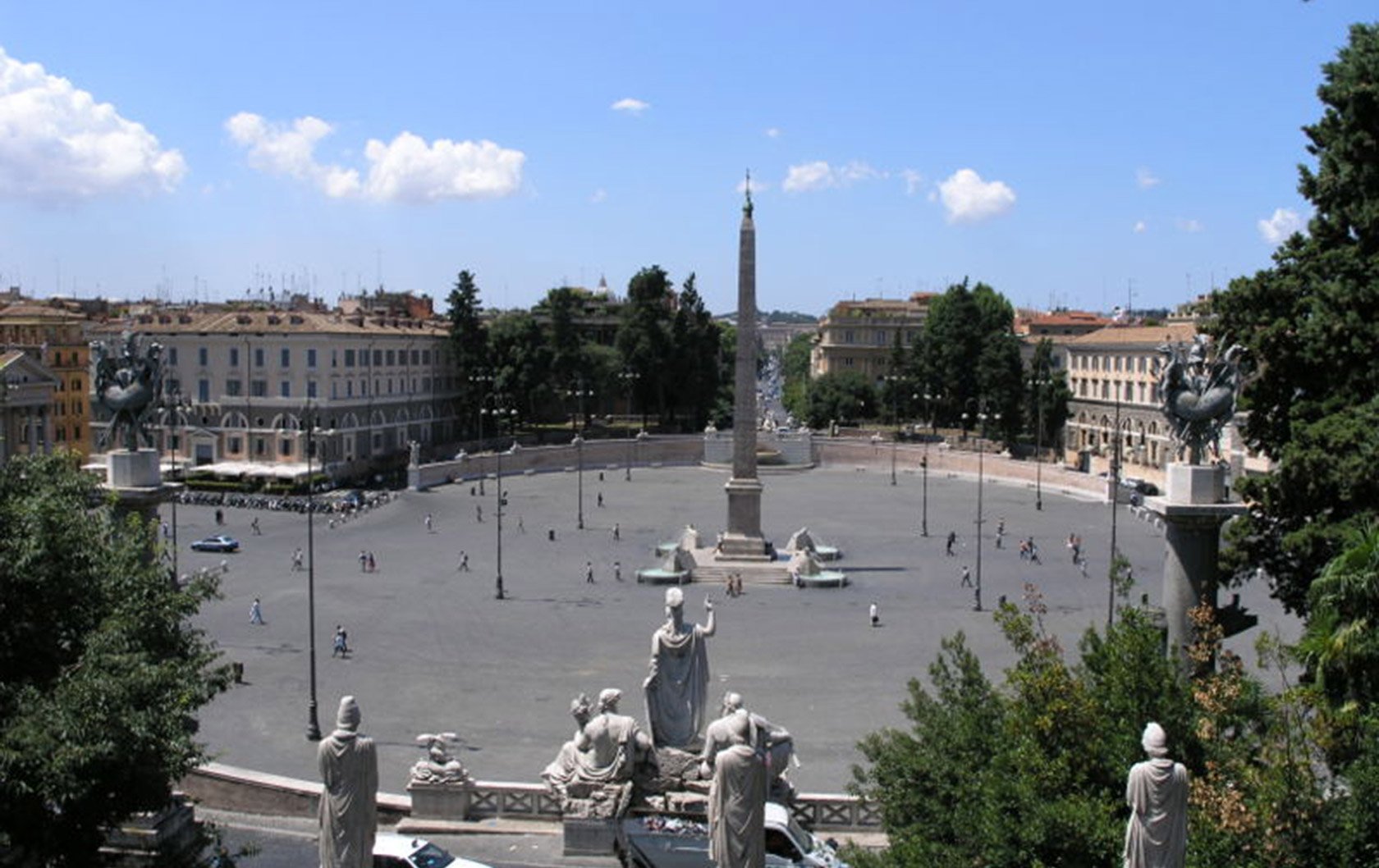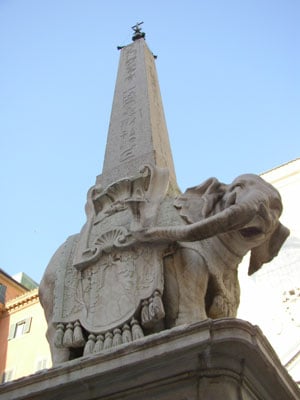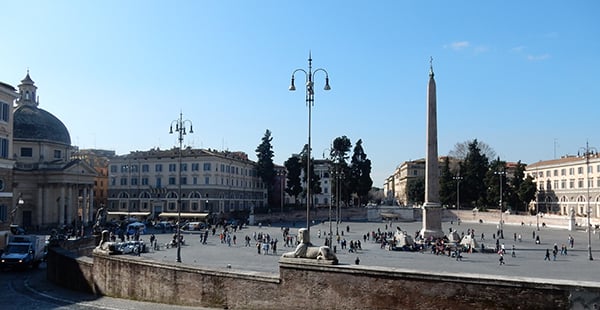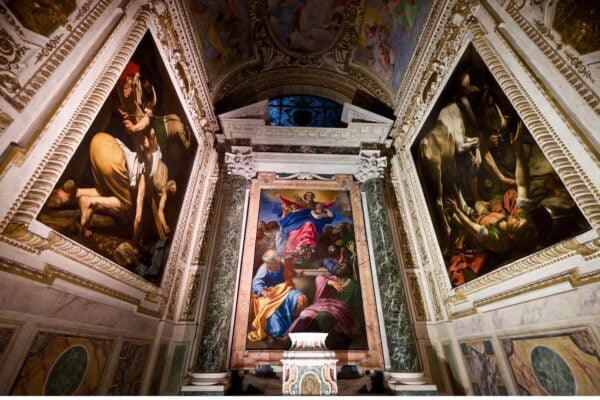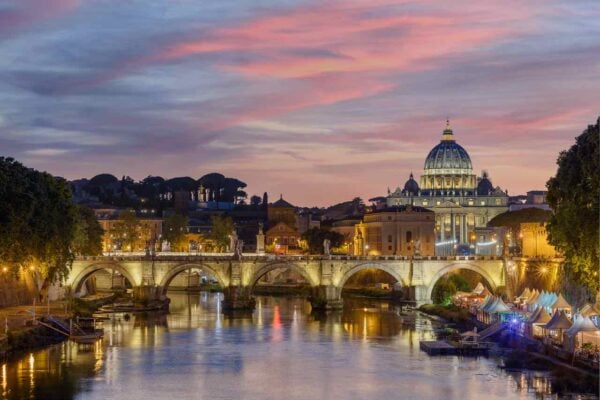The city of Rome has the most obelisks in the world! 13 true obelisks, stone pillars made from single blocks of stone.
They are all right in the city center; you can see them all in a day on foot and enjoy a
wonderful tour across the city. Here is a handy map.
Some are stunningly old, for example, the Lateran Obelisk was made for Egyptian pharaohs 1500 years BC (3500+ years ago!), then stolen, winding up in Rome 1700 years later. The same obelisk is the tallest in the world, too, at 32 meters, 105 feet. The stories of when they were commissioned, who stole them from Egypt and when (some actually were purchased), trace the history of the ancient world. You may note that Pope Sixtus V moved them about (also dug some up out of the ruins) to make a set of virtual sign posts for important stops on pilgrimages. Imagine walking from Northern Europe to Rome along the ancient Roman Via Flaminia, passing through the massive gate in the wall at Piazza del Popolo (that is still there) and being dazzled by the beautiful, expansive piazza with an amazingly hieroglyphic-covered spire of stone in the middle. You have arrived!
| Name, Location | Origin, History | Statistics |
| Lateran Obelisk
Piazza di San Giovanni in Laterano |
Oldest in Rome. Built in the 15th century BC for Pharaohs Tuthmosis III & IV for the Temple of Amon in Karnak, Egypt. Over 1700 years later, in 357 AD, emperor Constans II, son of Constantine the Great, had a special ship made for bringing the monument to Rome to decorate the Circus Maximus, the largest chariot racing stadium of the city. In 1587, it was dug up from rubble and placed here. | World’s Tallest
Origin: Egypt, 1600BC Height: 32m Height w/base: over 40m Weight: 230 tons |
| Vatican Obelisk
St. Peter’s Square |
This is the oldest monument in the square. There is a wonderful story about when the obelisk was being raised in the 1500s, silence on pain of death was decreed. It looked like the obelisk would fall because as men and horses pulled, the ropes stretched. Through the tense hours, a sailor finally shouted “put water on the ropes” to tighten the ropes and that solution saved the day. He was rescued from the death sentence and his family to this day has honors in the Vatican. | Origin: Egypt, 100BC
Height: 25.5m Height w/base & crest: 40.5m |
| Flaminian Obelisk
Piazza del Popolo The ancient Via Flaminio starts here. |
Made for Pharaoh Rameses II for his Temple of the Sun, Heliopolis. It was brought by Augustus and erected in the Circus Maximus. Put in Piazza del Popolo in 16th century, the Egyptian style lions of the surrounding fountain echo its origin. The Pincian Obelisk is very close to here. | Origin: Egypt, 1400BC
Height: 24m Height w/base: 34m |
| Pincian Obelisk
Pincio Hill Gardens, Via Obelisco |
This unadorned column originally stood over the grave of the beautiful youth Antinous, who drowned in the Nile while saving Emperor Hadrian’s life. It was erected here in 1822. | Origin: Rome, @300AD
Height 9.75m |
| Trinita dei Monti Obelisk
Top of Spanish Steps |
A Roman copy of the Flaminian Obelisk. Pope Pius VI moved it here at the end of the 18th century. | Origin: Rome, @300AD
Height: 13.92m |
| Psamtikos II Obelisk
Piazza di Montecitorio in front of the Parliament building |
A sun dial! The hole in the ball at the top casts light onto marks on the pavement. From Heliopolis, Egypt, Emperor Augustus brought it to Rome and placed it in the Campo Marzio, Field of Mars (the god of war), used for military training and sports where the obelisk was used as a big sundial. During the Middle Ages it was gradually buried under rubble. It was re-erected in the 18th century. A bronze globe with a hole was placed at the top that together with marks on the pavement made it a sundial again. | Origin: Egypt, 700BC
Height: 22m Height w/base & globe: 29m |
| Piazza Navona Obelisk
Piazza Navona |
Built for emperor Domitian’s temple to the Goddess Isis (look for her portrait with horns) and then was moved to form the center of the chariot race course which defines the shape of this piazza. | Origin: Rome, 100AD
Height: 16.54m Stone: Red granite |
| Esquilino Obelisk
Piazza del’ Esquilino behind Basilica di Santa Maria Maggiore |
One of “twin” obelisks, which once decorated the entrance of emperor Augustus tomb. No inscriptions. Both the Esquilino Obelisk and Quirinale Obelisk can be seen if you are at the crossing of Four Fountains, Quattro Fontane. Trinita dei Monti Obelisk also can be seen from here. | Origin: Rome, @100BC
Height: 14.8m Esquilino is higher than its twin by only 11 cm. |
| Quirinale Obelisk
Piazza del Quirinale (Official residence of the Italian President) |
Twin of Piazza dell’Esquilino Obelisk. In 1519, two obelisks were discovered underground at the entrance of the Great Tomb of Emperor Augustus. It was erected between the “horse tamers,” two huge roman statues of Castor and Pollux, the twin sons of Jupiter. Close to Trevi Fountain. | Origin Rome, @100BC
Height: 14.6m |
| Terme Obelisk
Viale delle Terme di Diocleziano, South Garden |
Topped by a star, it rests over a small monument in memory of the Italian soldiers who fell in the Battle of Dogali, Ethiopia, 1887. Twin of the obelisk in the Boboli Gardens in Florence. | Origin: Egypt, @1400BC
Height: 6.34m |
| Rotonda Obelisk
In front of Pantheon, Piazza della Rotonda |
Unearthed in 1575, this delicate monument came from the Temple of Isis, built nearby by Emperor Domitian. | Origin: Egypt @1400BC
Height: 6.34m red granite |
| Minerva Obelisk
Piazza della Minerva |
We love this miniature column, borne on the back of Bernini’s elephant. Another find from the Temple of Isis.
A Dominican monk who lost the contract to Bernini got the pope to force Bernini to put a block under the belly of the elephant for stability. Bernini didn’t like that, so he positioned the elephant’s rear facing the Dominican’s monastery. |
Origin: Egypt, @500BC
Height: 5.5m Height w/Base: 12.67m |
| Celimontana Obelisk
Villa Celimontana |
Originally, a companion to the Rotonda obelisk from the Temple of Ra in Heliopolis, near current Cairo. They were moved to the Temple of Isis in ancient Rome. In 1820, during the public ceremony on the day the obelisk was moved here, one of the workers was probably removing some gravel from the base where the obelisk, suspended just above, would soon rest, when the ropes holding the obelisk suddenly broke and its enormous weight came down, amputating the poor guy’s hands …which obviously should still be here, crushed under the obelisk’s base! | Origin: Egypt @1400BC
Height: 2.68m |
| Mussolini Obelisk
Lungotevere Marasciallo Diaz, Foro Italico |
Rome’s only true modern obelisk was erected by Mussolini, and it bears the words, “Mussolini Dux.” At the end of the Fascist regime, all public references to the Duce were outlawed and removed, but the letters on this 55-foot column were too large to be effaced, so they remain as a bizarre testament to the dictator’s megalomania. | Origin: Italy, 1932
Height: 17m Height w/base: 36m |
| Marconi’s Spire*
EUR, South of Rome *Not real obelisk, not one block of stone |
On the occasion of Rome’s Olympic Games in 1960, a tall spire was dedicated to one of Italy’s most important modern inventors, Guglielmo Marconi. The spire is made of concrete, although the panels, which illustrate Marconi’s merits and other allegorical scenes, are in white marble. | Origin: Italy, 1938
Height: 45m |
| Obelisks of Villa Torlonia
Via Nomentana |
The two obelisks carved with fake hieroglyphics, which stand in the gardens of Villa Torlonia, were made in the 19th century by Prince Alessandro Torlonia. At great expense, he had marble specially quarried in northern Italy and brought to Rome by boat: from Venice down the Adriatic coast to the Straits of Messina, up the western coast of Italy to the mouth of the Tiber, up the Tiber to the point nearest his villa. | Origin: Bayeno, Italy, 1840.
Height: if you find out, please email me feedback @KidsEurope |
| Comparison: Washington Monument
Washington, DC |
Technically not an obelisk at all, being built of thousands of individual stone blocks. It is also hollow and provided with a staircase and an elevator. | Height: 169m |
Photos by hslo (CC) and Dave Morris (CC)
